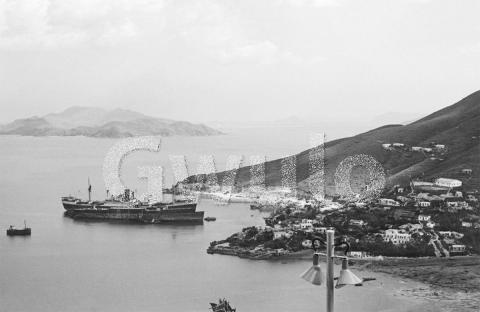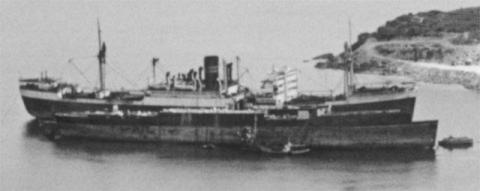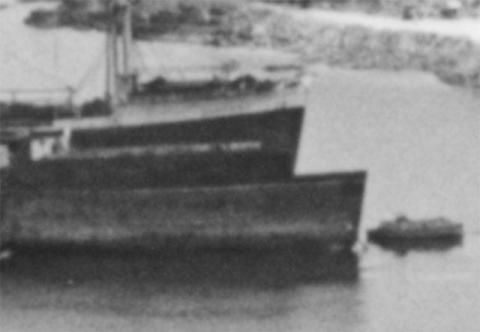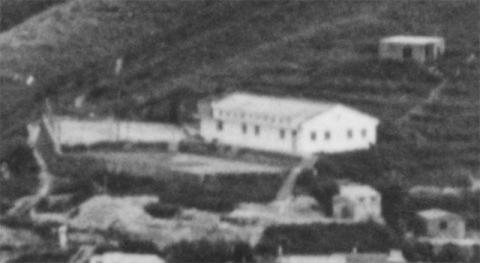1960s Rennie's Mill
Primary tabs
Where: The photographer is standing on a hillside, looking south across Rennie's Mill (today's Tiu Keng Leng). An earlier view from the 1950s was taken from a slightly different angle, and shows the main housing area was out of sight to the right of our photo. It also shows how the built-up area had expanded by the time this 1960s photo was taken.
In the right foreground is a shallow bay, roughly where Choi Ming Street passes the Metro Town Shopping Mall today. Then there's a ridge with buildings on, and beyond that there is reclamation underway, cutting away the slope and dumping the rock into the sea. That reclamation is the site of the Ocean Shores estate today.
The hills in the distance on the left belong to Junk island, and Tung Lung Chau island beyond it.
When: This is the second of three photos I bought together. The first was the photo I posted recently showing the capsized ship Cronulla off Sai Ying Poon. We've dated that to late 1962 / early 1963, and I'll assume this photo was taken around the same time.
Who: This community was first set up by Nationalist soldiers and their families in the 1950s. They'd escaped to Hong Kong from mainland China after their defeat by the Communist forces. We've met them previously when we looked at their temporary home on Mount Davis, where they lived for several months in 1950. An article on page 3 of The China Mail, 27 June 1950, describes their relocation to Rennie's Mill:
"Mount Davis refugees moved to new site at Junk Bay.
More than 4,000 refugee squatters from Mount Davis were moved in a mass exodus, to their new home at Rennie's Hill ((sic.)), Junk Bay, yesterday. There remain about 3,800 more to be moved, and it is expected this will be completed by today or tomorrow.
[...]
Removal of the refugees, who were mostly stranded Nationalist soldiers and their families, was under the supervision of the Government Social Welfare Office and the Tung Wah Group Hospitals, assisted by the district Kai Fong Welfare associations.
[...]
The new home of the refugees at Junk Bay will be 1,500 sheds, but of these only 300 have been completed, and until their completion the refugees will have to be put up in temporary tents.
[...]"
By the early 1960s, the number of residents in Rennie's Mill had grown as additional immigrants to Hong Kong found their way there.
What: There's a large ship in the bay.
The ship Cronulla in the previous photo had capsized as a result of Typhoon Wanda. I wondered if the ship in this photo was also one of the victims of the typhoon, but I didn't find any match in the gallery of "Damages and shipwrecks caused by Typhoon Wanda".
Looking more closely at the ship, there's a second hull lying next to it.
This area was one of the centres for Hong Kong's ship-breaking industry. When a ship reached the end of its life it would be broken up, and the steel recovered and re-used in Hong Kong's building industry. Was the ship in the photo here to be broken up?
It seems likely, though I'm not 100% clear when the first ship-breakers arrived in Junk Bay. Kenneth Lan, writing in his thesis "Rennie's Mill: the origin and evolution of a special enclave in Hong Kong", mentions a company starting work in 1964:
[...] in 1964, the Shui Wing Ship-breaking Company set up an operation adjacent to District 12, providing hundreds of well-paid jobs to the Rennie’s Mill residents who had the “strong physique and nerves to withstand the noise and heat.
That's just a bit too late for our photo though. Does anyone know when the first ship-breakers began work here?
I'd also be interested to hear from anyone who recognises any of the buildings on the slopes. eg there's a distinctive, larger building above most of the other buildings, with a flat area in front of it.
There were several missionary organisations in the area, so it may well have been one of their schools.
The missionaries' arrival in Hong Kong was for similar reasons to the Nationalist troops - the Communist victory meant they were no longer welcome on the mainland. Arriving in Hong Kong, the missionaries' fluency in northern dialects was of little use in Cantonese-speaking Hong Kong. But, it was just what was needed to communicate with the new residents of Rennie's Mill!
If you can add any information about this scene, or memories of life in Rennie's Mill, please share them in the comments below.
Regards, David
Gwulo photo ID: EM006







Comments
Renner mill
the ships
I have a photograph of ship breaking going on in Rennie's Mill in 1963. The ship in question I would suspect is one of the many WW2 survivors that were the mainstay of the immediate post-war recovery, but were beginning to come to the end of their useful lives by the mid-1960s. We are seeing two ships here. One nearer the camera with her upperworks entirely gone, the topsides of the hull mostly gone, with the plating in bow and stern sections down to the waterline (ships were often only broken up down to the keel). The other on the far side, still pretty much intact (including her funnel markings), I suspect is a 'Fort' (a WW2 standard) - distinguished by the separate bridge structure just forward of the main superstructure over the boilers and engine room (there was a hold entrance in the gap). Most of the rest of the 'jizz' (kingposts and derrick arrangement, davits, etc.) is consistent. Of the 'Forts', six were broken up in HK 1963-1966: Laagkerk (ex-Fort Orleans) in 1959; Alba Feliz (ex-Fort Bedford), Toula N (ex-Fort Sakisdac), Stanland (ex-Fort Tremblant) in 1963; Irene X (ex-Fort Poplar) in 1964; Marietta T (ex-Fort Colville) in 1966.
From the 'jizz' of the remains of the nearer vessel, I'd reckon she is a closely similar type.
Fuji Marden (joint effort between Wheelock Marden & Fuji Iron & Steel) were breaking in Junk Bay by 1963, as were Shui Wing in Rennie's Mill (see SCMP, 14th October 1963, p.6). A 1961 story (June 3, p.8) indicates that at that time ship breaking was not present in the Junk Bay/Rennie's Mill area but was about to be. The story says that the old Rennie's Mill military camp was to be turned into a resettlement area and that "land is being cleared nearby for the establishment of shipbreaking yards". The Fuji Marden steel re-rolling mill was under construction at Hang Hau in 1962 (SCMP, Feb 23 1962, p.16). In April (SCMP 4 April 1962, p.16) the Fuji Marden mill was scheduled to start work, as was that of Shui Wing. The first covered an area of 450,000 sq. ft. and the second 200,000 sq ft. They were expected to start work in July and for the second phase of construction to be completed in 1963.
It was reported in 1963 (SCMP, 7 June p.27) that as a result of reclamation in Victoria Harbour, in 1964 it was intended to move affected yards - from what I can see pretty much the other main players in Cheung Sha Wan, Ngau Tau Kok and maybe Gin Drinkers' Bay to Junk Bay. Looking at subsequent stories, this seems not to have happened because as far as I can work out, 1964 was around when the business began to slide in the face of competition from Japan. At this point the ship-breaking businesses (I haven't an exact number, but it looks like around three main breakers and a few smaller players) were employing 2,000 men. In 1959 that figure had been 4,000 with another 1,500 in the steel re-rolling mills. This is an index of the peak of the business, which appears to have been between c.1958 and 1961. The first big player seems to have been the Chiap Hua Manufactory Ltd. (also with some action in Singapore) originally making household goods and in 1948-49 recorded as buying its first ships for scrapping somewhere near Cheung Sha Wan. It had mills for processing the results and factories for making its products (steel bars, flash lights and army equipment (and some household goods like smoothing irons), which in 1954 were to be consolidated around a new steel mill employing 1,000 hands.
Sorry, most of that's irrelevant to this pic. My hunch would be 1963. In 1962 the first breakers had only just begun and there is the nice possibility of two of the three 'Forts' that were broken up here in 1963.
StephenD
Thanks for the replies, and
Thanks for the replies, and for the information about ship-breaking and possible ID of the ship. It's good to have confirmation that ship breaking was definitely underway in this area in 1963, and likely in 1962.
Regards, David
a better ID?
David, I think I may just have stumbled on a better answer. On 24 August 1962 the Clan Line's 1944-built ship Clan Chisholm (not a war standard - I fear I may have let my own preconceptions run away with me) was towed to Junk Bay to be scrapped by Shui Wing Steel Co. I have checked against a not so good photo of the ship (part covered by a watermark!) and stuff fits slightly better than for a 'Fort'. Perhaps most important the funnel marking is the same - in colour it would have been black with two horizontal red bands - and that fits. Interestingly she had been sold in the same year to the South African King Line, which had very different funnel markings, but it seems she was sent for scrapping before anyone got round to a new paint job. That gives a very much tighter date since no work seems to have been started on the ship proper, so my guess would be August/September 1962.
Best,
StephenD
ship breaking
Ship breaking was well under way during the 60's. I've got a series of aerial photographs I took - I've got them down as 'probably 1966' - showing a dozen ships in various stages of break-up.
ship breaking
The first record I have is from 1947, though I have indirect evidence of some work starting in 1946 with the first of the salvage clearances from the harbour. By the early 1950s shipbreaking is on a roll with the main mover and shaker being the Chiap Hua Manufactory Ltd (who stayed in that role through into the '60s). The peak year appears to have been 1960 when there were 15 firms in the business breaking up <90 or so ships a year tota;ling <500,000 gross tons, 60% of the steel of which was exported. At that point breaking was only going on in Kowloon Bay (Ngau Tau Kok principally), Cheung Sha Wan/Lai Chi Kok and in the general Gin Drinkers' Bay/Tsuen Wan area. Reclamation plans put the pressure on those sites and in 1962 the first two companies went into the Junk Bay/Rennies Mill area. (There is even one newspaper story that claims Junk Bay was called Junk Bay because ships were 'junked' there!) The other breakers stayed in business where they were, being progressivly squeezed by reclamations, a declining market and competition from Taiwan, so when finally everyone had had to move to the Junk Bay area c.1966 there were only half a dozen or so firms still in play. By 1970 Taiwan had replaced HK as the region's main breakers although ship breaking stories still crop up for Junk Bay as late as 1985, possibly a few years after that.
It was a very dangerous business for the poor guys who did the heavy lifting for HK$13 an hour. There were frequent fires, and health and safety were virtually non-existent. The worst figure I've seen, for I think 1959, was 34 deaths in a single year. One accident in Junk Bay in September 1968, which saw two ships on fire for 15-24 hours at Fuji Marden's yard killed five workers and injured 17.
StephenD
RENNIES MILL STUDENT AID PROJECT
Rennies Mill was the start of the "Rennies Mill Student Aid Project" in which a young missionary (David Taylor) came from the UK in 1956. It grew to be quite a large organisation with a number of hostels around Honk Kong. My father, Owen Hamilton, was on the initial committee and may well have been Chairman in about 1960. For a brief history of the Rennies Mill Student Aid Project see:
http://www.hksas.org.hk/en_history.html
Rennie's Mill
Between late 1969 and early 1972 I was living in the Officers' Mess of Lyemun Barracks on the high ground overlooking the village of Shaukeiwan. From there, there was a good view across the Lyemun Gap of Rennie's Mill. On one occasion I visited a restaurant there, the fare good & cheap, the sole disadvantage being that access to the noisome lavatory was via the kitchen and I the only 'foreigner' present. On the night before each 10th October 'The Double Ten' a date celebrated for the founding of The Republic of China, Nationalists living in Rennie's Mill habitually scaled the slopes above the place to erect large flags of the Republic. Well before the end of the day, these were removed by members of RHKP, usually by its Fanling-based Field Force, predominantly agile young men.
Rennie's Mill
Thanks for all the interesting memories and info about Rennie's Mill.
Tony, those are great aerial photos, thank you. I've added them in to your comment for you - here's a short "how to" in case you have more to add in future: https://gwulo.com/node/1929
Stephen, I agree that the Clan Chisholm is a much better match. Here's another photo of that ship for comparison:
SS Clan Chisholm, by Admin
Ship-breaking
The Hong Kong Annual Reports give another view of the rapid growth and decline of the ship-breaking business that Stephen described above. For this period I have copies of the reports for 1958, 1964, and 1968. Each report has the appendix "Industrial undertakings and persons employed in main industrial groups", with figures for the present and previous years. Under the "Shipbreaking" entry we have:
If you have the reports for the missing years, please could you let us know the figures?
numbers
David, I have a lot of numbers via newspaper reports that I think may cover most of the period. I haven't yet extracted them and tried to make sense out of them. I hope to do that soon and will post when I do.
A small add to Tony's photos. What the upper one is showing is the dramatic change that came about with the breaking as of the mid-1970s (when in any case it was in steep decline, with just a short rally in c. 1975-78 before the death spiral). This change was in part a result of the inquiry into the lethal 1968 fire, in part a function of continued complaint about pollution from the whole business, especially oil leaks, and trying at least in some way to compete with Taiwan.
Initially ships were broken up afloat. That's why the first sites in Ngau Tau Kok, Cheung Sha Wan and the Tsuen Wan area were chosen. They had shallow water into which the ships could be driven (all same Alang today) and then broken up, sometimes being winched into shallower water still as the steel disappeared, the wreck got lighter and drew less water. Initially Junk Bay was chosen for the same reason, but by the late '70s there was pressure on space, from Taiwanese competition and the problem of pollution which led to improved practices with ships being broken up alongside using cranes, which was higher tech and more expensive to do. I think Tony's upper picture is from when the move towards breaking up alongside is beginning.
In fact HK by the mid-70s was on a hiding to nothing. Wages were two to three times as high as Taiwan's. The maximum sized ship that could be broken up by the mid-70s (the limits had been different under the old system) was 6,000-7,000 tons and in Taiwan is was 300,000 (!). Worse, scrapping a 4,000 ton ship took HK workers c.80 days, whereas Taiwan's chaps could break up a 5,000 tonner in 25-30 days.
Shipbreaking finally ended c.1985 when government resumed all the sites and no more were on offer.
I've so far managed to identify the following companies that were shipbreakers in the late 1960s/early 1970s:
Four Seas Enterprises; Fuiji Marden; Chiap Hua Manufactory; Patt Manfield; Hung Da; Oceanic Industrial Corp.; Sigma Shipping; Dah Chong Hong; Chung Hing; HK Iron and Steelworks; Wise Investment Co.; Leung Yau; Kwong Cheung Hong; Lee Sing; Long Kee; Shiu Wing (out of shipbreaking by early 1970s); and Yau Wing.
The HK Shipbreakers Association had 25 members at one stage. Not sure whether that was the maximum. It seems to have included some members that may have only been steel re-rollers, not actual breakers, so the exact number of the latter is unclear. Equally, some players from the earlier years I haven't yet put names to.
StephenD